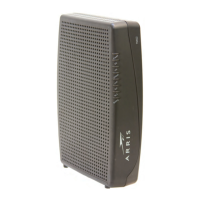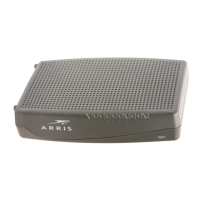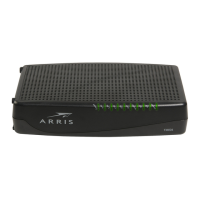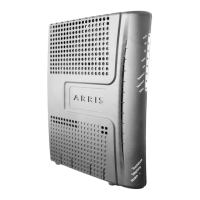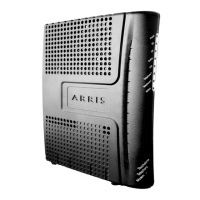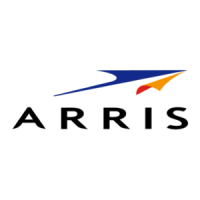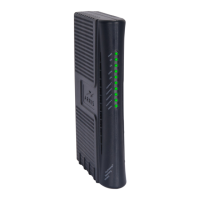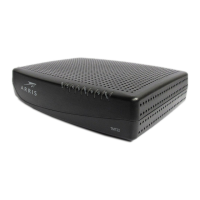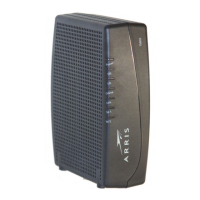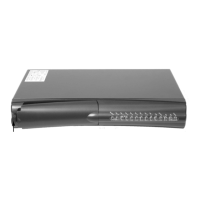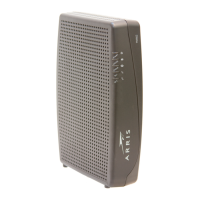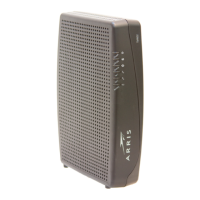Do you have a question about the Arris Touchstone TM822G and is the answer not in the manual?
Introduces the Touchstone TM822G modem's capabilities and benefits, including high-speed data and VoIP service.
Provides contact information and website for assistance with ARRIS products and user guides.
Outlines risks of equipment damage, loss of service, and electric shock when using the modem.
Details risks associated with battery handling, heating, and disposal to prevent fire or explosion.
Explains compliance with FCC Part 15 rules for digital devices to provide protection against harmful interference.
Covers RF exposure limits and regulatory compliance for Canada and Mexico.
Describes the modem's features, DOCSIS compliance, and capabilities for high-speed data and phone.
Lists the essential items included with the Telephony Modem package.
Lists necessary items for self-installation, including cables and optional hardware.
Guides users on contacting their service provider for account setup and information.
Details the necessary system requirements for using the Telephony Modem.
Specifies recommended computer hardware for optimal modem performance.
Lists supported operating systems for Windows, Mac OS, and Linux/Unix.
Explains how the manual covers the Telephony Modem and how to find the model number.
Provides tips for maintaining system security when connected to the internet.
Explains the Ethernet connection method for setting up a Local Area Network (LAN).
Explains the modem's battery backup feature for continued telephone service during power outages.
Details the basic backup battery models (green and black) and their backup times.
Describes extended and maximum backup batteries, their capacities, and physical changes.
Provides step-by-step instructions for installing or replacing the basic battery.
Details the procedure for installing or replacing the extended backup battery.
Provides instructions for installing or replacing the maximum backup battery.
Offers guidelines on battery life, calibration, and proper storage conditions.
Directs users to resources for responsible battery recycling.
Explains how to check the modem's battery status via a web browser interface.
Explains the function of each LED indicator on the front of the modem.
Identifies and describes the connectors and buttons on the rear of the modem.
Provides factors to consider when choosing a suitable location for the modem.
Covers options for wall or desktop mounting the modem.
Lists necessary tools and materials for wall-mounting the modem.
Details steps for securely mounting the modem on a wall.
Provides guidelines for placing the modem on a desk.
General guidance on connecting the modem to power and services.
Detailed steps for connecting coax, Ethernet, and telephone cables.
Lists prerequisites for configuring the Ethernet connection, including hardware and network info.
Explains the process for modifying TCP/IP settings for different operating systems.
Step-by-step guide for configuring TCP/IP settings on a Windows Vista system.
Instructions for configuring TCP/IP settings on Windows 7, 8, and 10 systems.
Steps for setting up TCP/IP configuration on a Mac OS X operating system.
Guides users on preparing their computer to use the modem's features.
Details the meaning of each LED indicator on the modem for troubleshooting.
Describes how to identify and resolve battery incompatibility issues.
Helps diagnose issues related to telephone wiring and modem indicator lights.
Illustrates light patterns indicating normal modem operation.
Explains LED patterns during telephony and cable modem startup sequences.
Explains how and when to use the modem's reset button for initialization.
Describes how to start the modem using its battery backup during power outages.
Guides troubleshooting steps when the modem's power light is off.
Helps resolve issues with establishing an internet connection.
Troubleshoots problems related to the Ethernet connection, including hub and cable issues.
Addresses common causes and solutions for slow internet speeds.
Guides users through diagnosing why there is no dial tone on the telephone lines.
Introduces the Touchstone TM822G modem's capabilities and benefits, including high-speed data and VoIP service.
Provides contact information and website for assistance with ARRIS products and user guides.
Outlines risks of equipment damage, loss of service, and electric shock when using the modem.
Details risks associated with battery handling, heating, and disposal to prevent fire or explosion.
Explains compliance with FCC Part 15 rules for digital devices to provide protection against harmful interference.
Covers RF exposure limits and regulatory compliance for Canada and Mexico.
Describes the modem's features, DOCSIS compliance, and capabilities for high-speed data and phone.
Lists the essential items included with the Telephony Modem package.
Lists necessary items for self-installation, including cables and optional hardware.
Guides users on contacting their service provider for account setup and information.
Details the necessary system requirements for using the Telephony Modem.
Specifies recommended computer hardware for optimal modem performance.
Lists supported operating systems for Windows, Mac OS, and Linux/Unix.
Explains how the manual covers the Telephony Modem and how to find the model number.
Provides tips for maintaining system security when connected to the internet.
Explains the Ethernet connection method for setting up a Local Area Network (LAN).
Explains the modem's battery backup feature for continued telephone service during power outages.
Details the basic backup battery models (green and black) and their backup times.
Describes extended and maximum backup batteries, their capacities, and physical changes.
Provides step-by-step instructions for installing or replacing the basic battery.
Details the procedure for installing or replacing the extended backup battery.
Provides instructions for installing or replacing the maximum backup battery.
Offers guidelines on battery life, calibration, and proper storage conditions.
Directs users to resources for responsible battery recycling.
Explains how to check the modem's battery status via a web browser interface.
Explains the function of each LED indicator on the front of the modem.
Identifies and describes the connectors and buttons on the rear of the modem.
Provides factors to consider when choosing a suitable location for the modem.
Covers options for wall or desktop mounting the modem.
Lists necessary tools and materials for wall-mounting the modem.
Details steps for securely mounting the modem on a wall.
Provides guidelines for placing the modem on a desk.
General guidance on connecting the modem to power and services.
Detailed steps for connecting coax, Ethernet, and telephone cables.
Lists prerequisites for configuring the Ethernet connection, including hardware and network info.
Explains the process for modifying TCP/IP settings for different operating systems.
Step-by-step guide for configuring TCP/IP settings on a Windows Vista system.
Instructions for configuring TCP/IP settings on Windows 7, 8, and 10 systems.
Steps for setting up TCP/IP configuration on a Mac OS X operating system.
Guides users on preparing their computer to use the modem's features.
Details the meaning of each LED indicator on the modem for troubleshooting.
Describes how to identify and resolve battery incompatibility issues.
Helps diagnose issues related to telephone wiring and modem indicator lights.
Illustrates light patterns indicating normal modem operation.
Explains LED patterns during telephony and cable modem startup sequences.
Explains how and when to use the modem's reset button for initialization.
Describes how to start the modem using its battery backup during power outages.
Guides troubleshooting steps when the modem's power light is off.
Helps resolve issues with establishing an internet connection.
Troubleshoots problems related to the Ethernet connection, including hub and cable issues.
Addresses common causes and solutions for slow internet speeds.
Guides users through diagnosing why there is no dial tone on the telephone lines.
| DOCSIS | 3.0 |
|---|---|
| Downstream Channels | 8 |
| Upstream Channels | 4 |
| Ethernet Ports | 1 |
| Voice Ports | 2 |
| Max Download Speed | 343 Mbps |
| Max Upload Speed | 131 Mbps |
| Compatibility | Compatible with major U.S. cable providers |
